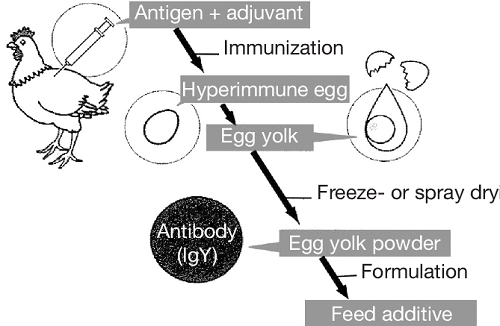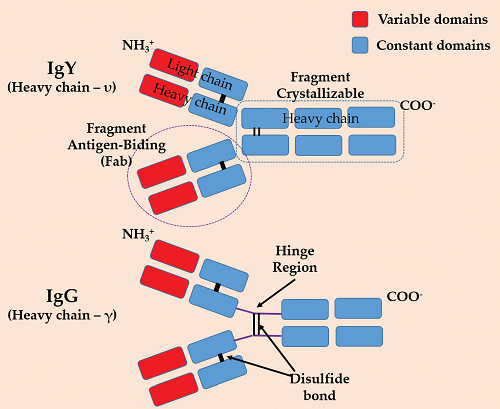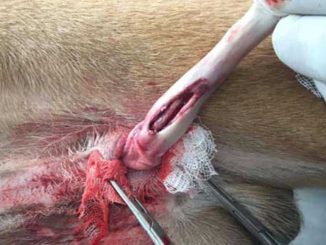Abstract
IgY production, a simple, non-invasive technology is a fascinating substitute to the traditional method of production of polyclonal antibody. Immunoglobulin Y (IgY) accounts for the primary antibody produced by chickens (Gallus gallus domesticus) which is recurrently synthesized, secreted into the chicken’s blood and finally gets relocated and collects in the egg yolk. When the production of IgY antibodies against a specific antigen is required, the layers are immunized with that particular antigen 3-4 times at weekly intervals and after this the IgY antibodies are purified from the yolk of their eggs. IgY purification is a relatively faster and an economic process of isolation that produces a large amount of specific antibody against a particular antigen. Antigen-specific IgY has been effectively been used against the diagnosis and treatment of canine diseases most importantly Canine Parvovirus and also Canine periodontitis. This review consists the information about the production and use of IgY for canine diseases.
Introduction
The application of IgY as therapeutics mark a new beginning in the field of immunotherapeutics in veterinary as well as medical medicine. The immunization of a hen can be a source of transfer of specific antibodies (Abs) into the egg yolk, was for the first time revealed experimentally by Klemperer in 1893 (Klemperer, 1893). IgY antibody production for therapeutics is considered to be an excellent way of non-invasive (instead of invasive method of bleeding) and large-scale production method of polyclonal antibody. The use of synthetically prepared antimicrobials may give rise to the problem of immune-suppression, hypersensitivity or anti-microbial resistance. All these are not noticed or may not likely to occur in case of IgY (Rahman et al., 2014).
Advantages of using IgY
- IgY is considered to be a useful and a safer alternative in all, ranging from young animals to the older ones
- Purification of chicken IgY antibodies from the egg yolk is a non-invasive method based on just collection of eggs, rather than the invasive method of stressful bleeding of animals for serum collection.
- Since IgY is polyclonal, directed against several epitopes of the antigens (which are created by several distinct genes, it is improbable to generate the problem of resistance
- IgY has a very good property of not binding to the rheumatoid factor, Fc receptor or the complement proteins of mammals and this can be helpful in avoiding false‐positive results
- It can be produced against different microbial species by specifically designing them to recognize the unique target sites
- It is an economic method. The cost of rearing poultry is comparatively lower than cattle rearing, if bovine milk or blood is to be used as the source of IgG.
- A substantial amount of antibody can be obtained from only one hen – an average of 17–35g of total IgY/chicken/year (out of which 1–10% can be presumed to be antigen-specific)
Production and Purification of IgY antibodies
The capacity of antibody production of a layer hen is much higher as compared to a mammal of similar size. The antibodies produced by the immune system of the challenged chicken are in accordance to the specific immunogen administered. It includes administration of the immunogen 3-4 times to the layer hens at weekly intervals. After this the eggs are collected and the yolk is separated from the egg albumin for the extraction of IgY from it. The IgY extraction from the egg yolk can be performed through various methods such as: water dilution method, chloroform-PEG method, by use of polyanionic polysaccharides such as xanthan, using dextran sulphate or other natural gums such as pectin, in association with affinity chromatography methods. In all these above methods the major objective is the effective separation of the lipid content from the protein.

Property of IgY
In serum, chicken IgY is a monomeric molecule, having a molecular weight of 165–206 kDa. The average serum concentration of IgY is 5–7 mg/mL and in yolk it is around 25 mg/mL. An average sized egg is supposed to contain around 100-150 mg of IgY. IgY is relatively heat stable. Most of the antibody activity remains after 15 min at 70°C. IgY is stable at a temperature range between 30°C-70°C. IgY activity and its structure is intact at pH above 4, but if incubated at pH 2 and at a temperature of 37°C, there is a rapid decrease in its activity. High concentrations of sucrose acts as a stabilizer for IgY against denaturation by heat, acidic environment and high pressure. It is observed that IgY fractions stored for upto 10 years in 0.9% NaCl, 0.02% NaN3 at 4°C experienced no serious loss of antibody titer. It is resistant against inactivation by trypsin and chymotrypsin, but is sensitive against dissolution by pepsin. The stability of IgY against pepsin is considered to be extremely dependent on pH and the ratio of the enzyme to the substrate. It is observed that the antigen-binding and cell-agglutinating activities of IgY along with its resistance to pepsin were intact at pH 5 or higher. The binding ability of IgY with the antigen declines with the increase in temperature and time of heating.

Uses of IgY
IgY is tool substantially utilized for therapy, immune testing, diagnosis and heterograft. In a particular study, chicken IgY was used to develop a double antibody sandwich ELISA for the detection of African horse sickness virus (Du-Plessis et al.,1999). There are well known examples of the use of IgY as a therapeutic or a prophylactic against Escherichia coli, Rotavirus and Coronavirus for the treatment of calves and piglets with specific Abs (Ebina, 1996). The egg antibodies have also been researched for their practical application in passive immunotherapy for the treatment of various diseases like Bovine Rotavirus in cattle and Mastitis in case of dairy cattle. The IgY technology is contemplated as a very effective, non-hazardous, easier, massive source of antibody, environmental friendly, and an economical replacement to the pharmaceutical as well as food industries.
Use of IgY in Canine Diseases
The use of IgY has also gained grounds in case of diagnosis and treatment of canine diseases. It has been proved that egg yolk-derived IgY can be administered intravenously in dogs to act as an assuring therapeutic against experimental Canine parvovirus-2 (CPV-2) infection as a severe clinical course of immunotherapy with yolk antibodies. In this no such adverse reactions were witnessed, rather it was observed that a higher dose performed better than a relatively lower dose. A study was also conducted in which the specific IgY antibody was produced against the CPV infection by immunizing the layer hens with CPV-VP2 protein expressed in E. coli. This anti-VP2-IgY could be exploited for its use into the diagnosis and treatment of CPV infection (Han et al., 2012). Young puppies in which vaccination failure may have occurred against the Canine Parvovirus and also the virus infected animals, can undertake the passive immunization either through immunoglobulins derived from chicken egg yolk (IgY) or through oral administration of immune colostrum against CPV-2. These IgY then eventually gets transported to the gastrointestinal tract and causes the inhibition of the attachment of the virus to intestinal epithelial cells. An ELISA for the diagnosis of CPV-2 infection has also been developed and has given authentic results. (Nguyen et al., 2006). Therefore, it can be said that administration of specific IgY may act as a powerful tool in the diagnosis and treatment of dogs having a clinical disease due to CPV-2. Anti-CPV-VLPs-IgY extracted from hen’s egg yolk based ELISA and immunochromatographic assay (ICA) has also been developed for the diagnosis of the presence of CPV infections of dogs. These diagnostic tests showed 97.06% and 94.12% confirmation of results in comparison to the detection by PCR. It exhibited high sensitivity and specificity (He et al., 2015).
Blocking the effect of gingipain, this IgY additive helps in blocking the effect of gingipains (GP) by the use of anti-IgY-GP. It aids in the interference of cell adhesion and thereby preventing the generation of periodontal pocket and ultimately the progression of the periodontal disease. The use of IgY-GP has given favorable results in the oral health of dogs and cats. It has helped in the reduction of diseased conditions like dental calculus and gingivitis in dogs and dental plaque in cats (Shofiqur et al., 2011). Immunoglobulin Y against gingipain (IgY-GP) has effectually appeared as an optimistic substitute to promote oral health as compared to the conventional prevention and treatment methods. For dogs, a dose rate of 35mg/kg of body weight once a day or 17.5mg/kg of body weight twice a day is appropriate to significantly reduce the dental calculus and gingivitis (Oba et al., 2018).
Future Prospect
The increasing resistance of microorganisms to the antimicrobials is the leading cause in the intensification of research on nearly all aspects analogous to the evolution of specific IgY against pathogenic microorganisms. Use of polyclonal IgY and scFvs may act as a promising alternative for proteomic studies. Since there is a presence of phylogenetic difference between chicken and mammals and therefore dissimilarity in antigenic profile recognition, the IgY technology may mark as a mechanism for the screening of new antigen libraries by the use of random phage display method and also in the selection of candidate targets for their application in therapy, diagnostics, or vaccine. In the coming future this technology can also be upgraded on various aspects such as: safe, pure and stable preparation of antibody without loss of its activity, better determination of most immunogenic immunogen candidate to raise an effective antibody, superior measurement of the amount of specific antibody produced, research on the molecules showing synergistic effect along with the produced antibody, effective analysis on the antibody’s adverse effects, methods of long-term preservation of the produced antibody.
Conclusion
Since, IgY is being utilized as an alternative to antimicrobials it can be effectively used for treatment of diseases in animals as well as humans. This may play an essential role in hindering the serious threat of emergence of multidrug resistant bacteria globally. Since poultry farming is carried out on a large scale globally, eggs may be a massive and an inexpensive (cost of animal care per unit production of antibodies is much less in chicken than in case of mammals) suitable source of antibody collection against different diseases. It has been reported that the amount of antibodies produced from an egg is equivalent to that from 200 to 300 ml of mammalian blood. This technology has a universal application in research in addition to medicine. It is even anticipated that IgY will play an efficacious role in the field of research. Avian antibodies are having a significant potential to be employed for further use in immunodiagnostics, immunotherapy, recognition of specific disease markers, treatment and prevention of disease.
References
- Du-Plessis D.H., Van-Wyngaardt W., Romito M., Du-Plessis M., Maree S. (1999). The use of chicken IgY in a double antibody sandwich ELISA for detecting African horsesickness virus. Onderstepoort J. Vet Res; 66: 25–8.
- Ebina T. (1996). Prophylaxis of rotavirus gastroenteritis using immunoglobulin. Archives.
- Han S., Zhang X., Zhao J. (2012). Production of Egg Yolk Antibody (IgY) against Recombinant Canine Parvovirus VP2 Protein. Acta Scientiae Veterinariae. 40(2): 1029.
- He J., Wang Y., Sun S., Zhang X. (2015). Evaluation of chicken IgY generated against Canine Parvovirus viral-like particles and development of enzyme-linked immunosorbant assay and immunochromatographic assay for Canine Parvovirus detection. Viral Immunology. 28(9):489.
- Júnior A.F., Santos J.P., Bassi P.B., Bittar J.F.F. Bittar E.R. (2017). IgY-Technology Applied to Studies of Toxoplasma gondii Infection.
- Klemperer F. (1893). Ueber natürliche Immunität und ihre Verwerthung für die Immunisirungstherapie. Archiv für Experimentelle Pathologie und Pharmakologie. 31: 356–382.
- Kumaran T. and Citarasu T. (2016). Igy-Technology: Production of Antibodies In Chickens and Use In Therapy Of Infectious Diseases. International Journal of Scientific Research and Modern Education (IJSRME). Volume I, Issue I.
- Nguyen S.V., Umeda K., Yokoyama H., Tohya Y., Kodam Y. (2006). Passive protection of dogs against clinical disease due to Canine parvovirus-2 by specific antibody from chicken egg yolk. Can. J. Vet. Res. 70: 62-64.
- Oba P.M., Rentas M.F., Vendramini T.H. and Brunetto M.A. (January 2018). Nutrition as a Tool to Control Periodontal Diseases in Dogs and Cats. Nutri Food Sci Int J. Volume 4 Issue 4.
- Rahman S., Icatlo F.C., Van Sa N. (2014). Immuno-Intervention with Immunoglobulin Y in Alimentary Tract Infections as an Alternative or Adjunct to Antimicrobials or Vaccines. Austin J Clin Med.1(3): 1013.
- Shofiqur R.A., Ibrahim E.S.M., Isoda R., Umeda K., Nguyen V.S. (2011). Effect of passive immunization by anti-gingipain IgY on periodontal health of dogs. Veterinary science development. 1(1): 8.
| The content of the articles are accurate and true to the best of the author’s knowledge. It is not meant to substitute for diagnosis, prognosis, treatment, prescription, or formal and individualized advice from a veterinary medical professional. Animals exhibiting signs and symptoms of distress should be seen by a veterinarian immediately. |







Be the first to comment